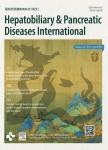Incomplete radiofrequency ablation promotes the development of CD133+cancer stem cells in hepatocellular carcinoma cell line HepG2 via inducing SOX9 expression
Incomplete radiofrequency ablation promotes the development of CD133^+ cancer stem cells in hepatocellular carcinoma cell line HepG2 via inducing SOX9 expression作者机构:Department of RadiologyBeijing Friendship HospitalCapital Medical UniversityBeijing 100050China Center of Interventional Oncology and Liver DiseasesBeijing Youan HospitalCapital Medical UniversityBeijing 100069China Beijing Institute of HepatologyBeijing 100069China Beijing Precision Medicine and Transformation Engineering Technology Research Center of Hepatitis and Liver CancerBeijing 100069China Department of Biochemistry and Molecular BiologyBaotou Medical CollegeBaotou 014040China
出 版 物:《Hepatobiliary & Pancreatic Diseases International》 (国际肝胆胰疾病杂志(英文版))
年 卷 期:2018年第17卷第5期
页 面:416-422页
核心收录:
基 金:supported by a grant from National Natural Science Foundation of China(81371546 and 61527807) Beijing Training Project For The Leading Talents in S&T(Z141107001514002) Health Industry Special Scientific Research Project(201402019) Beijing Municipal Administration of Hospitals’ Mission Plan(SML20150101) Beijing Scholar 2015(160) Capital Health Research and Development of Special Fund(2018-2-2182) the Beijing Municipal Science&Technology Commission(Z181100001718070)
主 题:Hepatocellular carcinoma Radiofrequency ablation HepG2 Cancer stem cells
摘 要:Background: Cancer stem cells(CSCs) accelerate the growth of hepatocellular carcinoma(HCC) residual after incomplete radiofrequency ablation(In-RFA). The present study aimed to detect the effects of In-RFA on stemness transcription factors(STFs) expression which are important for the production and function of CSCs, and to find which STFs promote HCC stemness after In-RFA. Methods: HepG2 cells were used for in vitro and in vivo studies. Flow cytometry and sphere-formation assays were used to detect the level and function of CD133~+ CSCs in the models. PCR array and ELISA were applied to analyze the altered expression of 84 STFs in CD133~+ CSCs in two models. Specific lentiviral shRNA was used to knockdown STFs expression, followed by detecting In-RFA’s effects on the levels and function of CD133~+ CSCs. Results: In-RFA was identified to induce CD133~+ CSCs and increase their tumorigenesis ability in vitro and in vivo. The mRNA levels of 84 STFs in CD133~+ CSCs were detected by PCR array, showing that 15 and 22 STFs were up-regulated in two models, respectively. Meanwhile, the mRNA levels of seven common STFs were up-regulated in both models. ELISA assay demonstrated that only the protein of sex determining region Y-box 9(SOX9) was up-regulated in both models, the protein levels of the other 6 common STFs did not increase in both models. Finally, SOX9 was identified to play an important role in inducing, maintaining stemness and promoting tumorigenesis ability of CD133~+ CSCs in both models. Conclusion: In-RFA-induced SOX9 stimulates CD133~+ CSCs proliferation and increases their tumorigenesis ability, suggesting that SOX9 may be a good target for HCC treatment.



